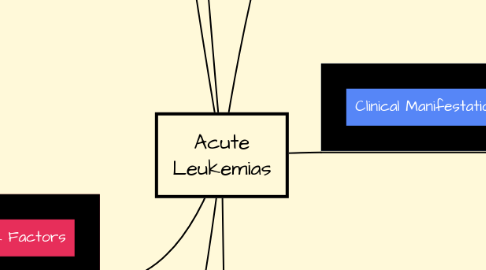
1. Diagnostic testing
1.1. Examination of blood cells
1.1.1. Presence of leukemic blast cells
1.1.2. stained peripheral blood smear will exhibit low RBC and platelet counts
1.2. Examination of bone marrow
1.2.1. hypercellularity: 60-100% blast cells
1.2.2. occasional normal myeloid
1.2.3. erythroid precursors
1.3. Early detection difficult
2. Eitology
2.1. Both Genders
2.1.1. Text book, exercises 34, 35, 36, 37
2.2. Seen in all ages
2.2.1. Incidence increases over 50 years of age
2.2.2. Children younger than 15= 1/3 of cancer deaths
2.2.3. Median age of diagnosis is 13
2.3. Clonal malignant disorder of leukocytes in blood and blood-forming organs
2.3.1. Uncontrolled proliferation of malignant leukocytes
2.3.2. Overcrowding of bone marrow
2.3.3. Decreased production of normal hematopoietic cells
3. Risk Factors
3.1. Unknown specific causes
3.1.1. prevention is impossible
3.2. Prenatal exposure to x-rays
3.3. Postnatal exposure to high-does radiation
3.4. Viral infections
3.4.1. HTLV-1
3.4.2. Epstein-Barr
3.5. Genetic conditions
3.5.1. Down Syndromes
3.5.2. neurofibromatosis
3.5.3. Shwachman Syndrome
3.5.4. Bloom Syndrome
3.5.5. Atatxia- Telangiectasia
3.5.6. 150 Stuctural chomosomal abnormalities
3.6. Developed countries and higher socio-economic
4. Findings
4.1. 5-year survival rate 38%
4.1.1. increased in children to 85%
4.1.2. Adults increased 65%
4.1.3. Influences
4.1.3.1. treatment methods
4.1.3.1.1. combined or multimodality
4.1.3.2. improved support servicecs
4.1.3.3. Nutritional support
4.1.3.4. Implementation of antimicrobial treatment
5. Clinical Manifestations
5.1. Bone marrow depression
5.1.1. fatigue
5.1.1.1. anemia
5.1.2. bleeding
5.1.2.1. thrombocytopenia
5.1.2.2. skin, gums, mucous membranes, GI/GU
5.1.3. fever
5.1.3.1. caused by infection
5.1.3.1.1. may have chills
5.1.3.2. oral cavity, throat, respiratory tract, lower colon, urinary tract, skin
5.1.3.2.1. organisms= gram negative bacilli
5.2. Anorexia
5.2.1. Occur in all forms
5.2.2. weight loss
5.2.3. diminshed sensitivity to sour and sweet
5.2.4. muscle atrophy
5.2.5. difficulty swallowing
5.3. abdominal pain, breast tenderness
5.4. CNS: cerebral/spinal inflitration
5.4.1. headache
5.4.2. vomitting
5.4.3. papilledema
5.4.4. facial palsy
5.4.5. blurred vision
5.4.6. auditory disturbances
6. Treatment
6.1. Bone Marrow transplantation
6.2. Chemotherapy
6.2.1. Treatment of choice
6.2.2. supportive measures
6.2.2.1. blood transfusion
6.2.2.2. antibiotics
6.2.2.3. antigungals
6.2.2.4. antivirals
6.2.3. sensitive to folic acid and asparagine deprivation
6.2.4. Stem-cell Transplantation
6.3. Myelosuppression
6.3.1. Consequence/ Treatment
7. Infections
7.1. Increased multisegmented neutrophils
7.1.1. opportunistic organisms
7.1.2. immune deficiency = chemotherapy/ disease
